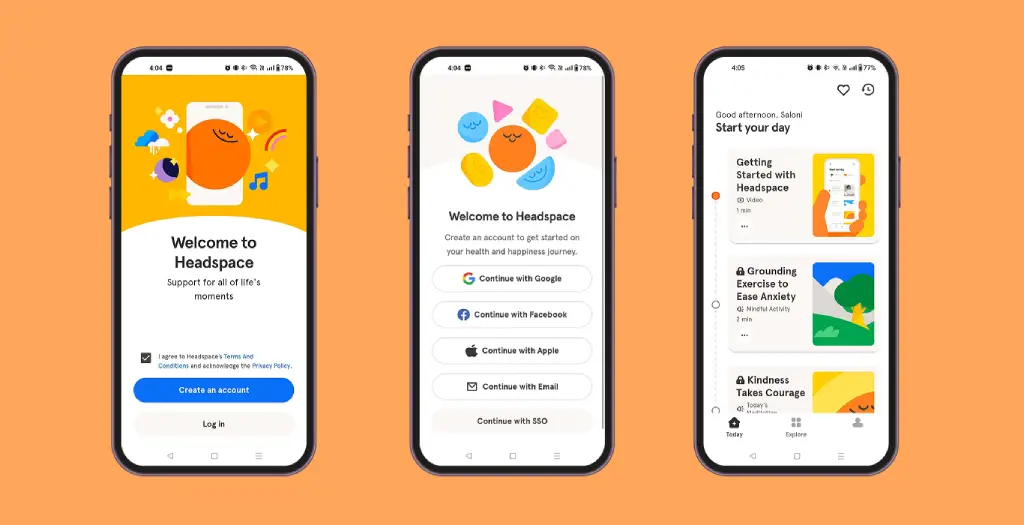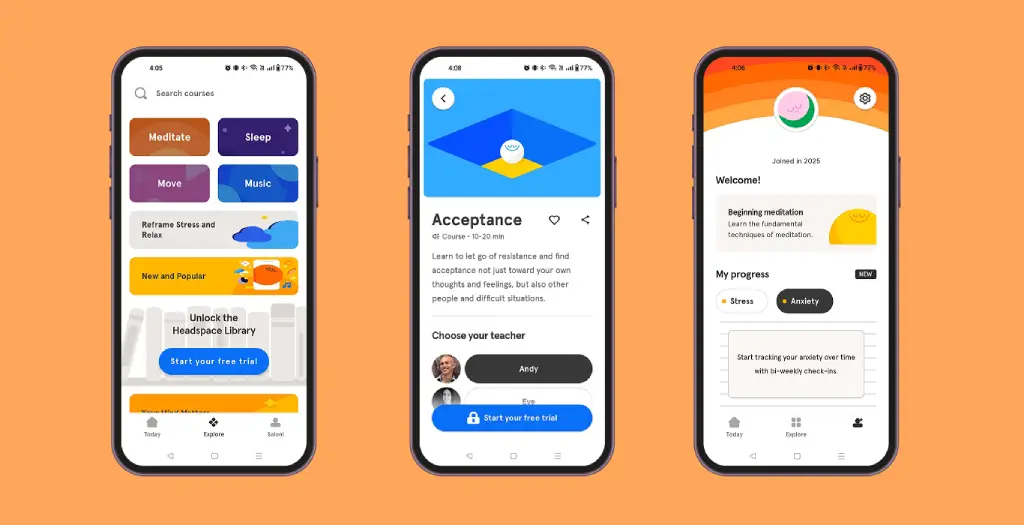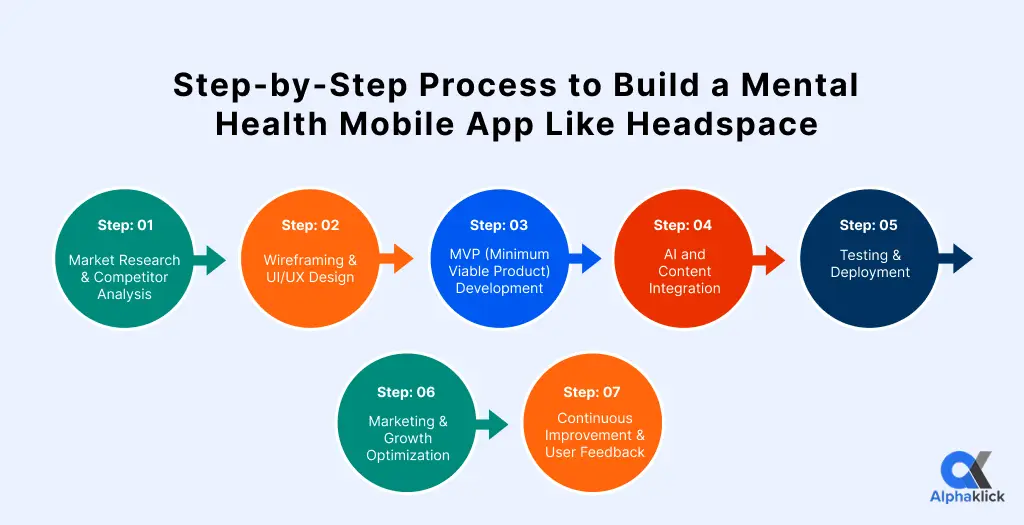Table of Contents
ToggleIn 2025, mental wellness has become more than just a personal goal; it’s now a global movement. Millions of people around the world are using digital solutions like Headspace and Calm to manage stress, improve sleep, and practice mindfulness every day.
As per Global Market Insights, the global mental health mobile app market was worth about USD 6.1 billion in 2023 and is expected to grow at a 17.9% annual rate from 2024 to 2032. This shows how quickly people are adopting technology for better emotional health and mindfulness.
From my own experience working on several mental health mobile app development projects, I’ve seen how the right features and design can truly help users build better habits and reduce anxiety through daily meditation sessions.
If you’re planning to build a meditation mobile app or create your own Headspace mobile app clone, this guide will walk you through everything, from market research and app design to the final launch, so you can bring your own mindfulness mobile app idea to life.
How Does Headspace Work?
Headspace is one of the best mental health mobile apps of 2025, trusted by millions for guided meditations, sleep sessions, stress management, and mindfulness exercises that blend effortlessly into everyday life. What makes it stand out is how simple and human it feels; you don’t need prior experience to start your wellness journey.
Its success comes from a strong mental health mobile app business model, offering free content for beginners while providing advanced meditation courses, sleep sounds, and focus programs through premium subscriptions. This balance helps Headspace serve a wide audience while maintaining a sustainable revenue model.
From my own experience working on mindfulness mobile app development, I’ve learned that what truly keeps users engaged isn’t just the technology, it’s how the app makes them feel.
A good mental health mobile app should be calming, easy to use, and emotionally intelligent. When design, sound, and AI-based recommendations come together smoothly, users don’t just open the mobile app; they form a daily habit that improves their well-being.

Core Features of a Mental Health Mobile App Like Headspace
When we build a wellness mobile app like Headspace, our priority is always empathy, creating tools that genuinely support users in their mental wellness journey. Over the years, I’ve seen that the best mental health mobile app development projects succeed when thoughtful design meets human understanding.
Here are the essential elements that make a mindfulness mobile app stand out:
1. Personalized Meditation Experiences
Every user’s mental health journey is unique. That’s why guided meditations should be adaptable, helping users relax, focus, or manage anxiety through structured audio sessions. When done right, these sessions become a daily ritual that improves mood and concentration.
2. Smart Emotional Assistance with AI
Artificial Intelligence brings a personal touch to mindfulness mobile app development. By analyzing user behavior, AI can recommend the right meditation, breathing exercise, or relaxation track, almost like having a digital wellness coach available 24/7.
Curious about how AI is changing the mobile app landscape? Explore how AI benefits mobile apps in various industries to see how innovation is shaping the future of wellness technology.
3. Better Sleep Through Calming Tools
Sleep directly affects mental clarity and emotional balance. Including meditation mobile app features like bedtime stories, deep sleep music, and soundscapes helps users establish healthy night routines and improve their rest quality.
4. Learning from Mental Health Experts
One reason Headspace stands out is its expert-led programs. Offering sessions by psychologists, meditation trainers, or therapists adds depth and credibility to your mobile app. It reassures users that they’re learning from trusted professionals.
5. Daily Reflection Through Journaling
Encouraging users to write a few lines each day, about gratitude, emotions, or goals, promotes self-awareness and mindfulness. A built-in journal becomes a personal space for emotional reflection and growth.
6. Safe Spaces for Real Connection
Connecting users with certified therapists or peer communities can make a real difference. It builds trust, reduces isolation, and turns your mobile app into a supportive environment where users feel heard and understood.
7. Motivation That Feels Rewarding
Consistency is key in mindfulness practice. Features like streaks, badges, or progress tracking make users feel rewarded for staying committed. This approach transforms mindfulness into a positive habit, not a task.
When all these elements come together, your Headspace mobile app clone can go beyond meditation; it becomes a trusted mental wellness companion. The goal isn’t just to build a mobile app; it’s to create something that helps people feel calm, connected, and cared for every single day.
Want to understand how smart health features are built? Explore the top health monitoring mobile app features and their development cost in 2025 to see which technologies dominate healthcare innovation.

Tech Stack for Mental Health Mobile App Development
The technology stack forms the foundation of any successful mental health mobile app development project. It determines how well your mobile app performs, how secure user data remains, and how easily the platform can scale as it grows.
Here’s an ideal combination of technologies we use to build wellness mobile apps like Headspace, designed for reliability, personalization, and long-term success.
| Component | Technology Used | Purpose |
| Frontend (UI) | Flutter / React Native | Build responsive, cross-platform mobile interfaces |
| Backend (Server Logic) | Node.js / Firebase | Manage sessions, user data, and push notifications |
| AI & Machine Learning | TensorFlow / OpenAI API | Personalize meditation suggestions and analyze emotions |
| Database (Storage) | MongoDB / PostgreSQL | Store user profiles, progress data, and journaling entries |
| Cloud Hosting | AWS / Google Cloud | Ensure scalability, uptime, and data security |
| Security & Integrations | Stripe / Firebase Auth / Mixpanel | Handle payments, authentication, and analytics |
Why This Stack Works
This tech stack offers the perfect balance of performance, flexibility, and security.
- Cross-platform development reduces cost and time without compromising quality.
- AI and ML integration help personalize experiences for each user.
- Cloud scalability ensures the mobile app runs smoothly even with high traffic.
- Data security and compliance build trust, a key factor in any mindfulness mobile app development journey.
Choosing the right technology isn’t just a technical decision; it’s about creating a strong foundation for a calm, reliable, and emotionally engaging experience.
This is the same proven framework our mobile app developers team follows for building Headspace mobile app clone projects and other mental wellness platforms that deliver real impact.
Step-by-Step Process to Build a Mental Health Mobile App Like Headspace
Over the years, I’ve guided many founders through this step-by-step mental health mobile app creation process.
Each stage plays a crucial role, ensuring the final product not only performs well but also connects emotionally with its audience.

Step 1: Market Research & Competitor Analysis
Before writing a single line of code, start by understanding who your mobile app is for and what problem it solves.
Are you targeting beginners looking to relax, or professionals seeking stress management tools? Analyze leading competitors like Calm, BetterMe, and Meditopia to identify gaps in meditation mobile app features, pricing, and user experience.
Use tools like Google Trends, Statista for market insights, and build a clear roadmap for your Headspace mobile app clone that differentiates your product from others.
Before you start planning your own wellness platform, check how much it costs to build a mental health mobile app like Headspace to estimate your development budget and strategy.
Step 2: Wireframing & UI/UX Design
The user interface defines the emotional tone of your mobile app. When you design a meditation mobile app, focus on a clean, calming layout with soft color palettes, intuitive navigation, and minimal distractions.
We often use Figma, Adobe XD, or Sketch to create wireframes and prototypes that visualize every screen before development begins. Adding gentle animations, mindful sound effects, and smooth transitions makes the mobile app feel peaceful and authentic.
Step 3: MVP (Minimum Viable Product) Development
Instead of building everything at once, start small with an MVP (Minimum Viable Product).
Include the core features of mental health mobile apps, such as guided meditations, AI-based mood tracking, and journaling, to test real user feedback early.
For development, cross-platform frameworks like Flutter or React Native are great choices. They allow you to launch on both iOS and Android simultaneously. Use Firebase for real-time notifications and Node.js for backend logic to ensure smooth performance and quick scalability.
Step 4: AI and Content Integration
AI-driven personalization is the future of mindfulness mobile app development.
Integrate TensorFlow, OpenAI, or Dialogflow to make your mobile app smarter, recommending meditation content, adjusting difficulty levels, and analyzing mood changes over time.
For content management, tools like Contentful or Strapi allow you to organize your meditation sessions, audio tracks, and therapy videos easily. Combine AI with curated human-led content to strike the perfect balance between technology and empathy.
If you’re planning to integrate artificial intelligence into your product, consider reading our guide on how to build an AI-powered mental health mobile app. It covers the must-have features, benefits, and cost breakdown.
Step 5: Testing & Deployment
A mental health mobile app must be fast, secure, and emotionally stable.
Before launch, conduct QA testing using tools like BrowserStack, TestRail, or Postman to ensure every meditation mobile app feature runs smoothly across devices.
You should also test for privacy compliance, especially if handling sensitive emotional data, by following HIPAA and GDPR standards. Once approved, deploy your app on Google Play Store and Apple App Store, using CI/CD pipelines (Jenkins, GitHub Actions) for smooth updates.
Step 6: Marketing & Growth Optimization
Even the best mobile apps need visibility and engagement strategies. Post-launch, focus on marketing efforts like app store optimization (ASO), influencer collaborations, and content marketing to reach your audience.
Inside the mobile app, use push notifications, referral programs, and gamified progress tracking to encourage consistent engagement. Offering limited-time free trials or community-driven challenges helps boost user retention, supporting a sustainable mental health mobile app business model.
Step 7: Continuous Improvement & User Feedback
Building your mobile app doesn’t end after launch; it evolves with your users.
Gather feedback through in-app surveys or analytics tools like Mixpanel, Amplitude, or Firebase Analytics. This data helps you identify what users love and where they drop off, so you can release frequent updates that improve experience and retention.
Every successful Headspace mobile app clone follows these principles, blending emotional design, advanced technology, and ongoing optimization.
When executed thoughtfully, your mobile app doesn’t just deliver mindfulness, it builds a loyal community of users who rely on it for balance and peace in their daily lives.
To plan your project efficiently, learn how much it costs to develop a healthcare mobile app in India and understand the factors that influence pricing in 2025.
Partner with AlphaKlick to Build a Mental Health Mobile App Like Headspace
Building a mental wellness mobile app isn’t just about development; it’s about creating something that genuinely improves lives. Over the years, my mobile app development team has helped startups and healthcare brands build wellness mobile apps like Headspace, integrating AI features, mindfulness-driven design, and secure cloud systems that scale globally.
As a leading mobile app development company in India, AlphaKlick specializes in healthcare mobile app development that blends technology with empathy. Our certified mobile app developers, UX designers, and strategists work together to craft digital experiences that feel calm, personal, and impactful.
If you’re ready to design a meditation mobile app that connects with users and promotes lasting well-being, we’d love to collaborate.
Book a free consultation today and take the first step toward building your next meaningful digital wellness product.
FAQs: Mental Health Mobile App Development
Question: How to build a mental health mobile app?
Answer: Start by understanding your target audience, defining clear goals, and working with experienced mental health mobile app development professionals. The process includes ideation, UI/UX design, MVP creation, and AI integration.
Question: How much does it cost to create a mental health mobile app?
Answer: The healthcare mobile app development cost ranges between $15,000 to $100,000, depending on the app’s complexity, number of features, and whether it’s built for iOS, Android, or both platforms.
Question: Are health mobile apps profitable?
Answer: Yes. Most successful mental wellness mobile apps use subscription or freemium models, making the mental health mobile app business model one of the most sustainable in the wellness tech space.
Question: How long does it take to develop a mental health mobile app?
Answer: On average, it takes 3–6 months to build a wellness mobile app like Headspace, depending on design complexity, number of screens, and AI integration level.
If you’re planning your project timeline, you can also look at the top 10 mobile app development companies in India to find trusted partners who specialize in wellness and healthcare mobile app solutions.

